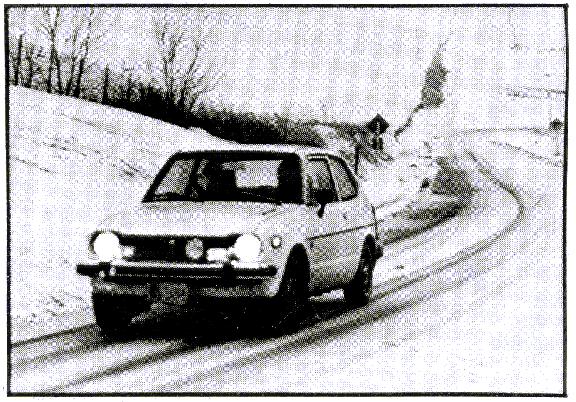This year's MOWOG was the sixth Winter rally of that name, and the second to be run under the St. Paul Winter Carnival's auspices. Sponsored in the past solely by the BMC Club of the Upper Midwest,. the rally has grown to the point that BMC and rallymaster Armand Peterson couldn't handle it alone. This year both Land O'Lakes Region of SCCA and the University of Minnesota Sports Car Club co-sponsored the event. Course workers came from the sponsoring clubs and from other Twin Cities sports car clubs.
After signing in at the registration point, rallyists lied their cars inspected for safety--brakes, headlights, signals and wheel bearings were checked. The Tech Inspectors also looked for the required tow cable and safety flares.
Car no. 11, driver Harry Argetsinger and I left the start point at the Ramada Inn at 12:11 PM. An 8-mile long tire warm-up and a 28-mile long odometer check took us south on Highway 61 and across the St. Croix River into Prescott, Wisconsin.
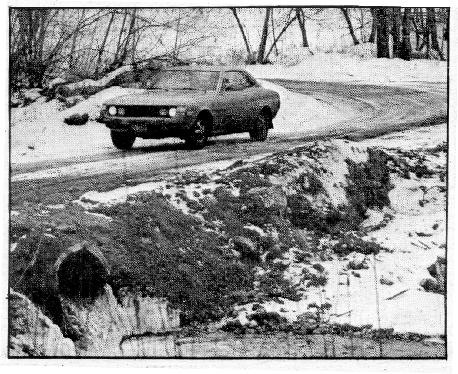
As rally cars cover the course, they come upon checkpoints where the time they enter the checkpoint is recorded. The exact time to cover the course at the required average speed is known, and the rally car's actual tine is compared to this. On the MOWOG, and on many winter rallies, timing is to the minute instead of to the second--a team receives no penalty points for being from 0 to 59 seconds late, 1 penalty point for being 60 to 119 seconds late, etc. On the MOWOG, the penalties are doubled for being early.
At- one point, rallymaster Peterson had positioned a checkpoint just around a bend and over a hill from the previous checkpoint, hoping to catch people leaving the previous control before their official Out Time. Fortunately, Harry and I had been talking about something or other and had not been paying attention to the time;. we were 30 seconds late when we finally got our act on the road. We got a nice zero instead of the two-point penalty we probably deserved.
The rest/supper break at the midpoint of the rally was in Mondovi, Wisconsin at the Valley Supper Club, where most competitors ordered the "Road Rallye Special" of roast beef tips. The rallyists were allowed. a couple of restful hours of bench-racing before the grueling night-time half of the rally was to begin.
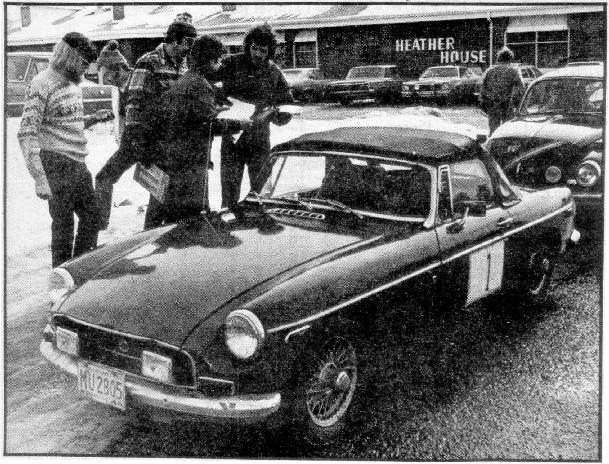
Car No. 1, entered by rallyists Chris Zur and Lona Bradbury. As
First Car Out, they had the dubious honor of being the first competitors on the course.
Photo by Bryan LaPlante
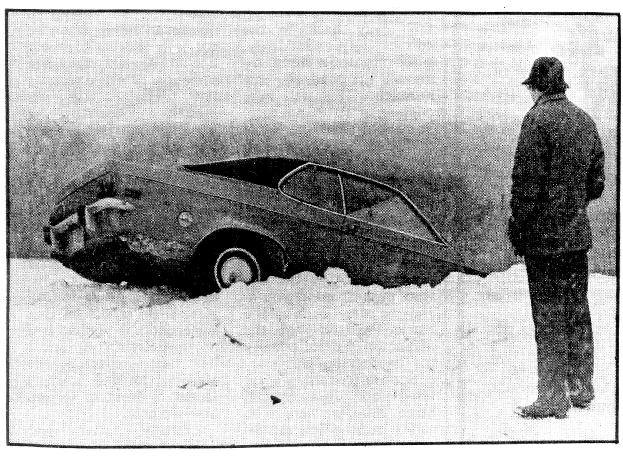
Standing in the late afternoon snow, Scott Forehand contemplates the meaning of life . . . The Opel was later rescued, and Forehand and driver Don Andrews went on to finish 10th. Photo by Bryan LaPlante
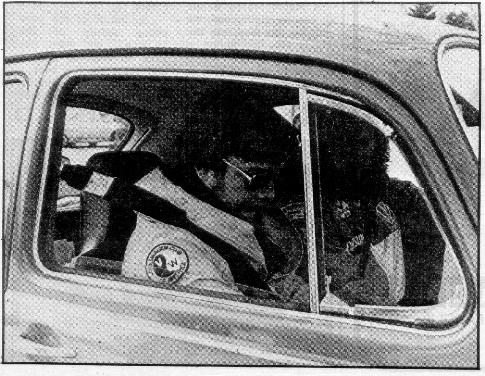
Navigator Mark Voskuil and driver Steve Jackson studying the Route Instructions as their out time approaches. Photo by Bryan LaPlante
Instruction no. 15 of the second half read "Left second opportunity," and we were to turn left the second chance we had: Along with many other teams, most of whom should have known better, we somehow got onto the wrong road. (We realized this when rally cars started coming back at us on their way back to the correct turn.) Suddenly, while motoring along, using all the road, we saw headlights as we were clipping a left-hand turn. Somebody had the nerve to dispute our line through the corner, and, rather than give the audacious rallyist his just deserts by hitting him, we took the more prudent course and dived into a snowbank. A quick shove--the navigator is ALWAYS the one who pushes, mind you--and we were back in the battle. We received the maximum 5 point penalty for that leg, though.
Soon afterward, we entered our first Special Stage. Here, we were to be timed to the nearest 30 seconds, with a maximum penalty of 15--and no points for being early. Of course, the average speed to be maintained was 50 m.p.h. and the "road" (I hesitate to use the term) was an unplowed two-rut forest trail. No early penalties, indeed!
We were sent on the second Special Stage at 10:34, with assurances from the workers that nobody was getting stuck. Again we churned into the woods--for about a quarter of a mile, when we got into another eight-car line-up. A Volkswagen had somehow managed to get a flat tire! The car was literally picked up by impatient rallyists, and the tire changed. Another 15 points.
By 11:11 PM, our start of the third and last Special Stage, Harry was understandably suffering driver fatigue, and we were three minutes late for a six point penalty. I was satisfied--we had had to ford three little creeks on that stage, and nobody had tied up traffic. With our luck, I had been expecting the Martians to land a flying saucer in front of us and have a picnic.
Finally, after 132 miles of night rallying, and over 260 total rally miles (not including the mileage we accumulated by driving down the wrong roads) we entered the end-point of the rally in Prescott. It was 1:00 AM, almost thirteen hours after we had left the Twin Cities.
As proof of the punishing nature of the MOWOG, we were too tired to even sit around and enjoy the free beer, a true indication that a road rallyist is really out of it.
###
1976 MOWOG Winter Carnival Rally
TOP 12 FINISHERS
